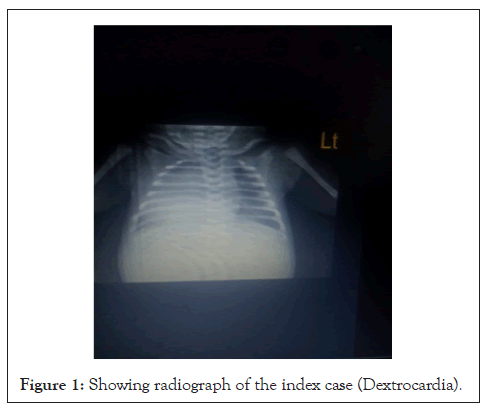Clinical & Experimental Cardiology
Open Access
ISSN: 2155-9880
ISSN: 2155-9880
Editorial - (2021)Volume 12, Issue 6
Dextrocardia is an abnormal situs which occurs when the apex of the heart points to the right and inferiorly. Dextrocardia could occur in isolation or may occur concomitantly with other cardiac lesions. It could also occur with abnormal rotation of the atrium and visceral organs (situs inversus totalis). Complex cardiac anomalies coexisting with dextrocardia with certain endocrinepathies are rare occurrence. We report a 2-month-old female who presented with breathlessness, cyanosis and subclinical features of congenital hypothyroidism from birth. The child was previously managed as neonatal jaundice, but after phototherapy, clinical signs of jaundice persisted. Further examination revealed splitting of the second heart sound and a very faint grade 2 ejection systolic murmur located at the second left intercostal space. Chest radiograph and echocardiography revealed dextrocardia and transitional Atrio-Ventricular (AV) canal defect respectively. He is presently been worked up for AV canal repair and thyroid assay result is been waited. Dextrocardia coexisting with AV canal defect and congenital hypothyroidism are rare combination of complex cardiac defect. High index of suspicion, timely diagnosis and appropriate referral will help avert morbidities and mortality associated with this lesion
Heart defects; Atrio-ventricular canal defect; Dextrocardia; Child; Echocardiography
Dextrocardia is an abnormal situs which occurs when the apex of the heart points to the right and inferiorly. Dextrocardia could occur in isolation or may occur concomitantly with other cardiac lesions. It could also occur with abnormal rotation of the atrium and visceral organs (situs inversus totalis). Complex cardiac anomalies coexisting with dextrocardia with certain endocrinopathies is a rare occurrence. We report a 2-month-old female who presented with breathlessness, cyanosis and subclinical features of congenital hypothyroidism from birth. The child was previously managed as neonatal jaundice, but after phototherapy, clinical signs of jaundice persisted. Further examination revealed splitting of the second heart sound and a very faint grade 2 ejection systolic murmur located at the second left intercostal space. Chest radiograph and echocardiography revealed dextrocardia and transitional Atrio-Ventricular (AV) canal defect. He is presently been worked up for AV canal repair and thyroid assay result is been waited. Dextrocardia coexisting with AV canal defect and congenital hypothyroidism are rare combination of complex cardiac defect. High index of suspicion, timely diagnosis and appropriate referral will help avert morbidities and mortality associated with this lesion. Congenital Heart Defects (CHD) are one of the commonest congenital malformations seen in children [1]. It is reported that about 25% of heart defects are life threatening in origin [2]. In certain conditions, a child may present with complex congenital heart disease and situs abnormality, which may be caused by a constellation of embryological, environmental and genetic accidents. We report a case of dextrocardia in a child with transitional Atrio-Ventricular (AV) canal defect and subclinical congenital hypothyroidism.
Clevenger, et al. [2] has reported a complex cardiac anomaly in a child presenting with a mirror image dextrocardia and transitional Atrio-Ventricular (AV) canal defect. He noted that management of a child with dextrocardia and AV canal defect may pose some challenges especially in a developing country.
We present a case of a 2-month-old female who presented with breathlessness and jaundice from birth. Examination revealed apex beat located at the 4th right intercostals space and loud second heart sound with a soft grade 2ejection systolic murmur located at the second left intercostals space. Subclinical features of congenital hypothyroidism were jaundice at first day of life with serum bilirubin showing conjugated hyperbilirubinemia, umbilical hernia and poor cry at birth. Chest radiograph and echocardiography revealed dextrocardia and transitional AV canal defect respectively (Figure 1). Abdominal ultrasound and Liver function test results were normal. However, thyroid function test result was been awaited.

Figure 1: Showing radiograph of the index case (Dextrocardia).
Dextrocardia and Transitional AV Canal defect coexisting with conjugated hyperbilirubinemia and subclinical congenital hypothyroidism are rare congenital anomaly. Few studies have shown combination of AV canal defect with dextrocardia alone but none has demonstrated these four combinations. For instance, Cervadoro, et al. [3] documented a rare case of dextrocardia in a child with AV canal defect but rather presented with duodenal atresia. They recommended that early prenatal diagnosis and appropriate referral may help in early identification of the anomaly and appropriate management instituted. Ecan, et al. [4] also noted that out of 136 children with Down syndrome, 72.6% had congenital heart disease with over 20% presenting with AV canal defect and 12% of them presenting with congenital hypothyroidism. It is expedient to have congenital or subclinical hypothyroidism as a strong differential in children with AV canal defect who present with episodes of conjugated hyperbilirubinemia especially at first day of life. This will help the clinician to monitor such child and intervene early.
Dextrocardia coexisting with AV canal defect and congenital hypothyroidism are rare combination of complex cardiac defect. High index of suspicion, timely diagnosis and appropriate referral will help avert morbidities and mortality associated with this lesion.
Citation: Chinawa JM (2021) A Rare Association of Dextrocardia and Transitional AV Canal Defect in a Child with Conjugated Hyperbilirubinemia and Subclinical Congenital Hypothyroidism. J Clin Exp Cardiolog.12: 1000e678.
Received: 21-Jun-2021 Accepted: 05-Jul-2021 Published: 12-Jul-2021 , DOI: 10.35248/2155-9880.21.12.e678
Copyright: © 2021 Chinawa JM. This is an open-access article distributed under the terms of the Creative Commons Attribution License, which
permits unrestricted use, distribution, and reproduction in any medium, provided the original author and source are credited.